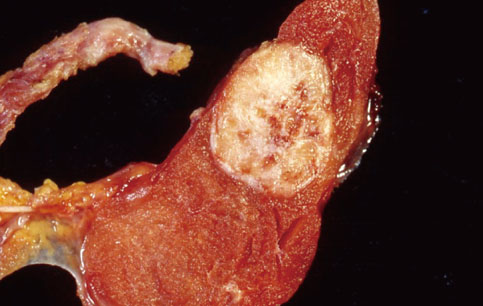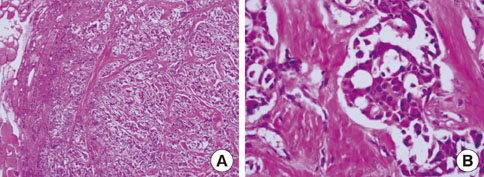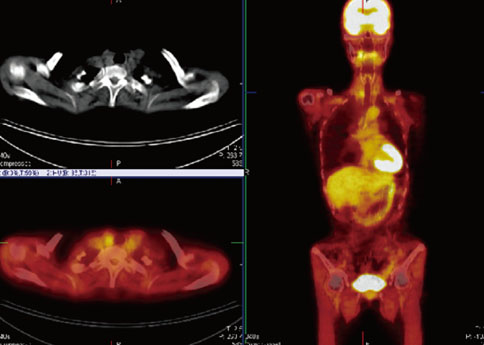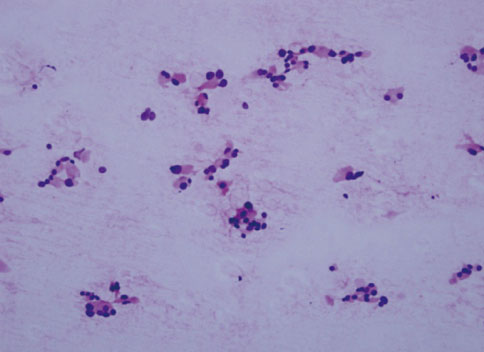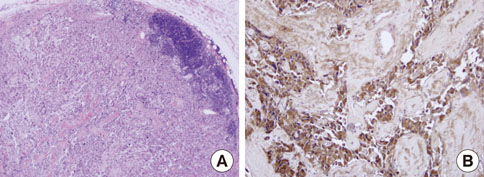Endocrinol Metab.
2010 Dec;25(4):365-369. 10.3803/EnM.2010.25.4.365.
A Case of Residual Medullary Thyroid Carcinoma Detected by 18F-FDG-PET/CT in Patient with Persistent Hypercalcitoninemia
- Affiliations
-
- 1Department of Endocrinology and Metabolism, Soonchunhyang University Hospital, Seoul, Korea. chkim@schmc.ac.kr
- 2Department of Pathology, Soonchunhyang University Hospital, Seoul, Korea.
- KMID: 1497764
- DOI: http://doi.org/10.3803/EnM.2010.25.4.365
Abstract
- Medullary thyroid carcinoma (MTC) is a rare and challenging malignancy. In patients with residual MTC, the tumor detection rate is generally low for most of the currently available imaging techniques. Various imaging methods have already been used for the detection of residual tumor, but no modality has been shown to be superior to others. 18F-fluorodeoxyglucose positron emission tomography/computed tomography (18F-FDG PET/CT) has recently been proposed to identify residual MTC, but this procedure also has limitations as small masses are rarely detected. So, a multimodality imaging approach is recommended for detecting residual MTC. We report here on a case of residual MTC that was detected by 18F-FDG PET/CT in a patient with persistent hypercalcitoninemia after total thyroidectomy and bilateral lymph node dissection.
MeSH Terms
Figure
Reference
-
1. Fernandez Vila JM, Peix JL, Mandry AC, Mezzadri NA, Lifante JC. Biochemical results of reoperations for medullary thyroid carcinoma. Laryngoscope. 2007. 117:886–889.2. Fialkowski E, DeBenedetti M, Moley J. Long-term outcome of reoperations for medullary thyroid carcinoma. World J Surg. 2008. 32:754–765.3. Weber T, Klar E. Minimal residual disease in thyroid carcinoma. Semin Surg Oncol. 2001. 20:272–277.4. Szakáll S Jr, Esik O, Bajzik G, Repa I, Dabasi G, Sinkovics I, Agoston P, Trón L. 18F-FDG PET detection of lymph node metastases in medullary thyroid carcinoma. J Nucl Med. 2002. 43:66–71.5. Nanni C, Rubello D, Fanti S, Farsad M, Ambrosini V, Rampin L, Banti E, Carpi A, Muzzio P, Franchi R. Role of 18F-FDG-PET and PET/CT imaging in thyroid cancer. Biomed Pharmacother. 2006. 60:409–413.6. Giraudet AL, Vanel D, Leboulleux S, Aupérin A, Dromain C, Chami L, Ny Tovo N, Lumbroso J, Lassau N, Bonniaud G, Hartl D, Travagli JP, Baudin E, Schlumberger M. Imaging medullary thyroid carcinoma with persistent elevated calcitonin levels. J Clin Endocrinol Metab. 2007. 92:4185–4190.7. Ong SC, Schöder H, Patel SG, Tabangay-Lim IM, Doddamane I, Gönen M, Shaha AR, Tuttle RM, Shah JP, Larson SM. Diagnostic accuracy of 18F-FDG PET in restaging patients with medullary thyroid carcinoma and elevated calcitonin levels. J Nucl Med. 2007. 48:501–507.8. Rubello D, Rampin L, Nanni C, Banti E, Ferdeghini M, Fanti S, Al-Nahhas A, Gross MD. The role of 18F-FDG PET/CT in detecting metastatic deposits of recurrent medullary thyroid carcinoma: a prospective study. Eur J Surg Oncol. 2008. 34:581–586.9. Schott M, Willenberg HS, Sagert C, Nguyen TB, Schinner S, Cohnen M, Cupisti K, Eisenberger CF, Knoefel WT, Scherbaum WA. Identification of occult metastases of medullary thyroid carcinoma by pentagastrin-stimulated intravenous calcitonin sampling followed by targeted surgery. Clin Endocrinol(Oxf). 2007. 66:405–409.10. Ball DW. Medullary thyroid cancer: monitoring and therapy. Endocrinol Metab Clin North Am. 2007. 36:823–837.11. Kloos RT, Eng C, Evans DB, Francis GL, Gagel RF, Gharib H, Moley JF, Pacini F, Ringel MD, Schlumberger M, Wells SA Jr. American Thyroid Association Guidelines Task Force. Medullary thyroid cancer: management guidelines of the American Thyroid Association. Thyroid. 2009. 19:565–612.12. Moley JF, DeBenedetti MK. Patterns of nodal metastases in palpable medullary thyroid carcinoma: recommendations for extent of node dissection. Ann Surg. 1999. 229:880–887.13. Machens A, Hinze R, Thomusch O, Dralle H. Pattern of nodal metastasis for primary and reoperative thyroid cancer. World J Surg. 2002. 26:22–28.14. Franc S, Niccoli-Sire P, Cohen R, Bardet S, Maes B, Murat A, Krivitzky A, Modigliani E. French Medullary Study Group (GETC). complete surgical lymph node resection does not prevent authentic recurrences of medullary thyroid carcinoma. Clin Endocrinol (Oxf). 2001. 55:403–409.15. Koopmans KP, de Groot JW, Plukker JT, de Vries EG, Kema IP, Sluiter WJ, Jager PL, Links TP. 18F-dihydroxyphenylalanine PET in patients with biochemical evidence of medullary thyroid cancer: relation to tumor differentiation. J Nucl Med. 2008. 49:524–531.16. Rendl G, Manzl M, Hitzl W, Sungler P, Pirich C. Long-term prognosis of medullary thyroid carcinoma. Clin Endocrinol (Oxf). 2008. 69:497–505.17. Simon GH, Nitzsche EU, Laubenberger JJ, Einert A, Moser E. PET imaging of recurrent medullary thyroid cancer. Nuklearmedizin. 1996. 35:102–104.
- Full Text Links
- Actions
-
Cited
- CITED
-
- Close
- Share
- Similar articles
-
- 18F-FDG PET/CT and Sonographic Findings of Thyroid Incidentalomas
- A Case of F-18 FDG PET-CT Detection of Sporadic Medullary Thyroid Carcinoma and Cervical Lymph Node Metastasis of Ovarican Cancer
- Application of Simultaneous 18F-FDG PET/MRI for Evaluating Residual Lesion in Pyogenic Spine Infection:a Case Report
- Clinical Significance of Diffuse 18F-FDG Uptake in Residual Thyroid Gland after Unilateral Thyroid Lobectomy
- Use of 18F-FDG PET/CT in Second Primary Cancer

